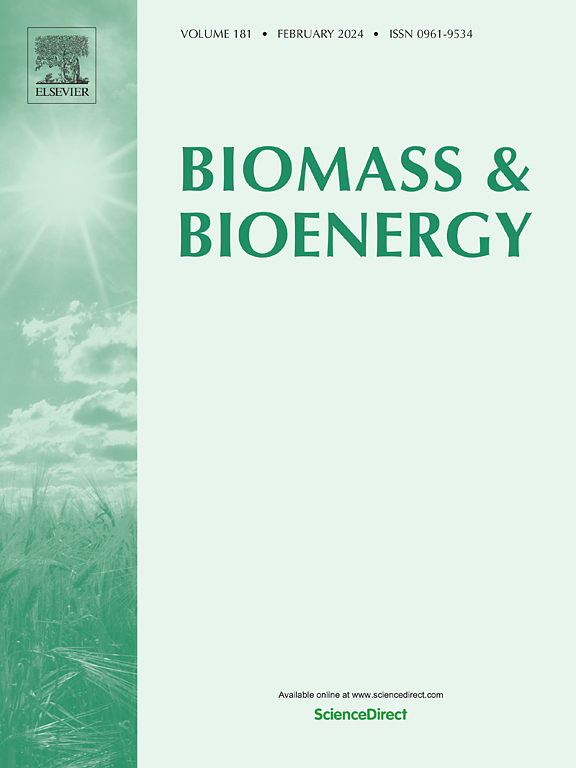Thermodynamic and environmental analysis of two-stage series supercritical water gasification of biomass for hydrogen production
IF 5.8
2区 生物学
Q1 AGRICULTURAL ENGINEERING
引用次数: 0
Abstract
A system of two-stage series supercritical water gasification of biomass is proposed to achieve high hydrogen production. The system design and process simulation were implemented via Aspen plus, and the thermodynamic performance of the system was analyzed. Meanwhile, a life cycle environmental assessment under different conditions was performed using SimaPro. Based on the fixed reaction concentration, results of thermodynamic analysis reveal that the energy efficiency and exergy efficiency of the system are related to temperatures of the first-stage gasification reactor and the second-stage oxidation reactor. When temperatures of FGR and SOR are 603°C and 833°C respectively, the system could reach the highest hydrogen production. Moreover, the energy efficiency and exergy efficiency could reach 54.9 % and 56.2 % respectively, while changes of temperatures of the first-stage oxidation reactor and the second-stage gasification reactor have no effect on efficiency. In addition, the maximum recoverable energy loss is induced by the waste heat of the effluent from Cooler, indicating the path of system optimization. By using organic Rankine cycle, the energy efficiency and exergy efficiency could reach 57.7 % and 59.3 % respectively. Meanwhile, the data from SimaPro shows LCI and LCIA of the system, which identified the main environmental burdens. Overall, this work has great advantages in terms of thermodynamics and environmental impact, while it faces both opportunities and challenges. This research reveals the feasibility of TSCWG and provides theoretical guidance for biomass cleaning conversion.
生物质两级串联超临界水气化制氢的热力学和环境分析
为实现高产氢,提出了一种生物质两级串联超临界水气化系统。通过 Aspen plus 实现了系统设计和过程模拟,并分析了系统的热力学性能。同时,使用 SimaPro 进行了不同条件下的生命周期环境评估。基于固定的反应浓度,热力学分析结果表明,系统的能效和放能效与一级气化反应器和二级氧化反应器的温度有关。当 FGR 和 SOR 的温度分别为 603°C 和 833°C 时,系统的产氢量最高。此外,能量效率和放能效率分别达到 54.9% 和 56.2%,而一级氧化反应器和二级气化反应器的温度变化对效率没有影响。此外,冷却器排出的废热引起了最大的可回收能量损失,这为系统优化指明了道路。通过使用有机朗肯循环,能量效率和放能效率可分别达到 57.7 % 和 59.3 %。同时,SimaPro 的数据显示了系统的 LCI 和 LCIA,确定了主要的环境负担。总之,这项工作在热力学和环境影响方面具有很大的优势,同时也面临着机遇和挑战。这项研究揭示了 TSCWG 的可行性,并为生物质清洁转化提供了理论指导。
本文章由计算机程序翻译,如有差异,请以英文原文为准。
求助全文
约1分钟内获得全文
求助全文
来源期刊

Biomass & Bioenergy
工程技术-能源与燃料
CiteScore
11.50
自引率
3.30%
发文量
258
审稿时长
60 days
期刊介绍:
Biomass & Bioenergy is an international journal publishing original research papers and short communications, review articles and case studies on biological resources, chemical and biological processes, and biomass products for new renewable sources of energy and materials.
The scope of the journal extends to the environmental, management and economic aspects of biomass and bioenergy.
Key areas covered by the journal:
• Biomass: sources, energy crop production processes, genetic improvements, composition. Please note that research on these biomass subjects must be linked directly to bioenergy generation.
• Biological Residues: residues/rests from agricultural production, forestry and plantations (palm, sugar etc), processing industries, and municipal sources (MSW). Papers on the use of biomass residues through innovative processes/technological novelty and/or consideration of feedstock/system sustainability (or unsustainability) are welcomed. However waste treatment processes and pollution control or mitigation which are only tangentially related to bioenergy are not in the scope of the journal, as they are more suited to publications in the environmental arena. Papers that describe conventional waste streams (ie well described in existing literature) that do not empirically address ''new'' added value from the process are not suitable for submission to the journal.
• Bioenergy Processes: fermentations, thermochemical conversions, liquid and gaseous fuels, and petrochemical substitutes
• Bioenergy Utilization: direct combustion, gasification, electricity production, chemical processes, and by-product remediation
• Biomass and the Environment: carbon cycle, the net energy efficiency of bioenergy systems, assessment of sustainability, and biodiversity issues.
 求助内容:
求助内容: 应助结果提醒方式:
应助结果提醒方式:


